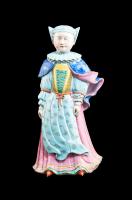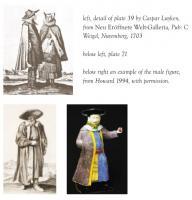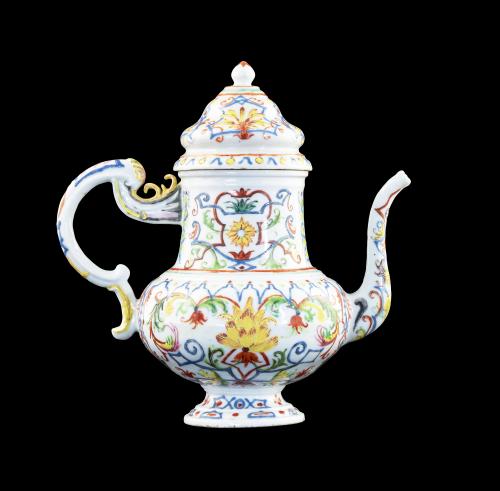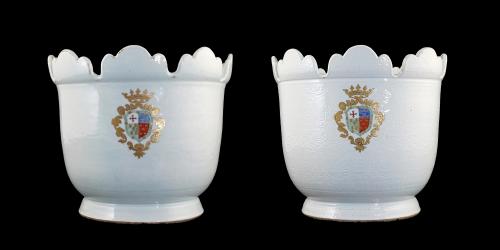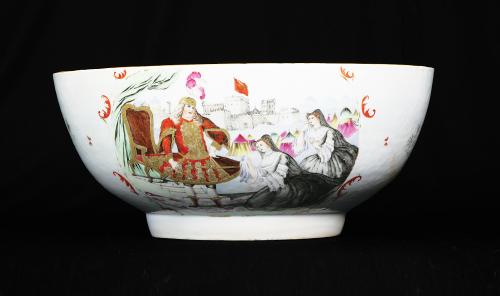
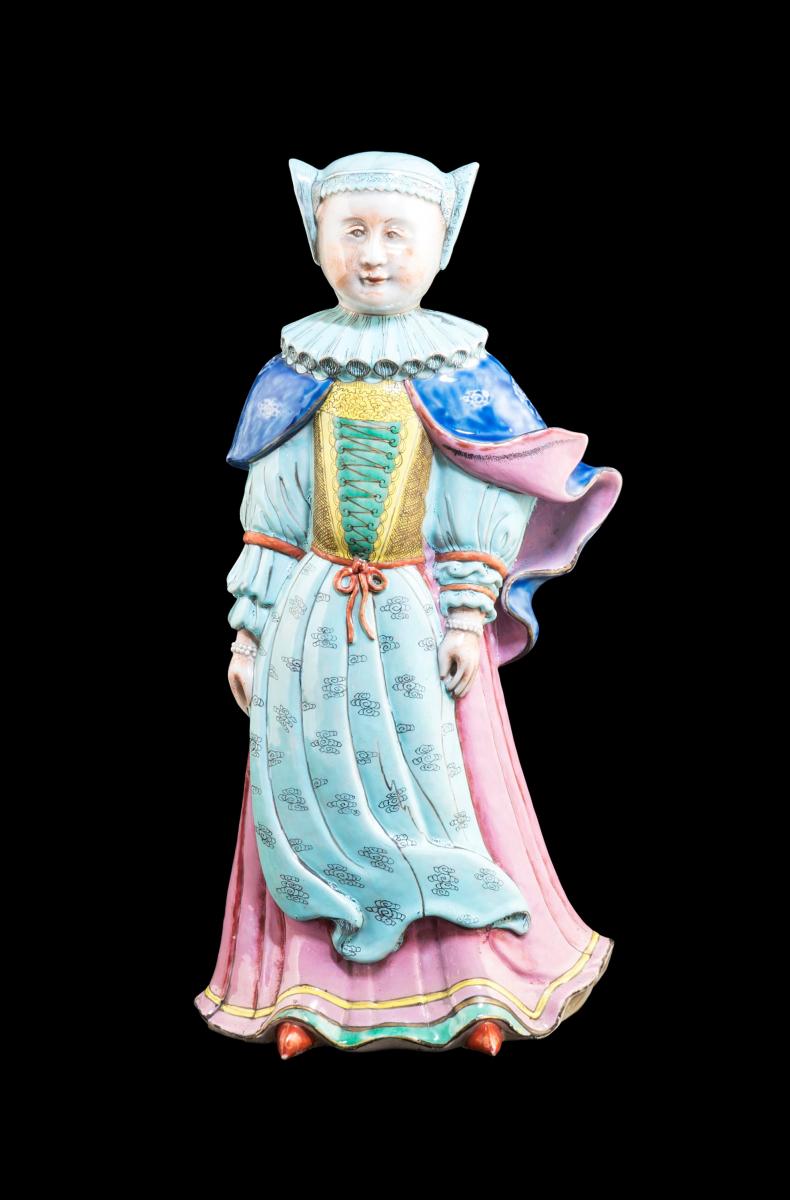
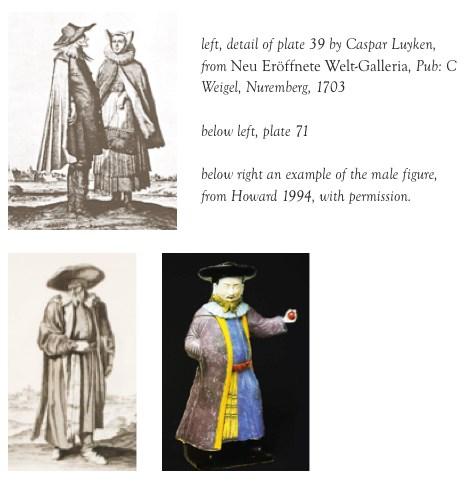
This object is eligible for a Certificate of BADA Provenance
The BADA Standard
- Since 1918, BADA has been the leading association for the antiques and fine art trade
- Members are elected for their knowledge, integrity and quality of stock
- Our clients are protected by BADA’s code of conduct
- Our dealers’ membership is reviewed and renewed annually
- Bada.org is a non-profit site: clients deal directly with members and they pay no hidden fees
Chinese export porcelain figure of a lady in Jewish Dress.
Qianlong period circa 1740.
Dutch or English Market.
Height: 16 inches; 42cm
An extremely rare Chinese famille rose porcelain figure of a standing woman dressed in the formal clothes of the Frankfurt Jewish community.
This figure is one of only three known different models of this size and decoration, with thick enamelling. The other two are a bearded man holding out his left arm with a purse (a pair to this figure) and a Turkish dancer. All are extremely rare, with five examples of the Turkish girl recorded and about a dozen of the others, more of the women known than men.
They were a private order about 1740, but it is not clear for which market they were intended or who might have ordered them. All three derive from European prints but with modifications - suggesting either that the order specified the changes, or that they derive from intermediate prints as yet undiscovered.
This figure and the male companion were long described as a Dutch couple but research by Ronald Fuchs has shown that they are in fact wearing the Jewish costume of 16th century Frankfurt, as illustrated in a print by Caspar Luyken, circa 1703, of a Jewish couple, plate 39.
The male figure is not too close to the man in this print but the costume is from another print, plate 71, by Luyken from the same book, of a Polish Jewish figure, (thought by some to be a portrait of the Ruthenian Jewish scholar Nathan Hannover) though the pose differs.
It is unclear why Jewish figures should have been chosen at this time but it does seem to be deliberate as these two prints, the only ones of Jewish costume, have been selected out of the whole book.
Many Sephardic jews were involved in trade with the East, based in Amsterdam and London, and some ordered Chinese Armorial dinner services so might have commissioned such figures. However the dress on these figures is of Ashkenazi Jewish type and they were generally less wealthy than the Sephardis. So it remains a mystery.
The prints come from two series of exotic foreign costume collections and the fashion for such things in the second quarter of the eighteenth century may have prompted the order without any particular distinction. The Turkish dancer is from a print by Henri Bonnart, circa 1702.
A pair of these male figures was in the ship's cabin of Admiral John Byng described as 'Dutch Merchants', from a label on the reverse of the male figure in the Hodroff Collection. So the misidentification is almost contemporary.
References: Fuchs, Ronald 2008, European Subjects on Chinese Porcelain, Oriental Ceramics Society; For couples see: Sargent 1991, p112; Howard 1994, p252, a couple in the Hodroff Collection; for ladies see: Mengoni et al 2013, p140, a lady from the British Museum (No 1963,0422.11); another is in the Victoria & Albert Museum (No C.94-1963); Howard & Ayers 1978, p612; du Boulay 1963, p82; Williamson 1970, pl XLI; For Admiral Byng: Finlay, Robert (2010) The Pilgrim Art: Cultures of Porcelain in World History, University of California Press, p287; M John Cardwell 2004, Art and Arms: Literature, Politics and Patriotism During the Seven Years War, Manchester University Press, p60+; Cohen & Cohen 2013, p68, an example of the Turkish Dancer; information about Historical Jewish dress from Dr. Cornelia Aust, Leibniz-Institut für Europäische Geschichte (IEG) pers. comm.
Related Figures: Although the body of this figure is made from moulds, many of the smaller details were worked by hand in the potters’ workshop in the finishing stages, as well as the enamelling all being done by hand too. In particular the bow at her waist and the distribution of the cloud motifs painted in grey on the turquoise apron appear to be unique to each example.
By examining these in the published examples that we have found, at least 19 different examples can be differentiated, in two groups possibly from two separate orders (the main difference is the colour on the underside of the cape flap - either pink or purple). A second order could explain the relative rarity of the male figure in comparison to the female, with the second order either having a problem with the male figures (lost or damaged?) - or it could be that it was intended to have only pairs of the ladies following the more usual pairs of Chinese maiden figures.
These include:
1. British Museum
2. Victoria & Albert Museum
3. Winterthur Museum (Hodroff/Mottahedeh)
4. with Vanderven & Vanderven, 2015
5. Sotheby’s London, sold 2011
6. Cohen & Cohen 2014B
7. Peabody Essex Museum
8. Cohen & Cohen 1990
9. ex Martin Hurst coll, Williamson 1970, pl XLI
10. Cohen & Cohen 2017 - this example here
11. Christie's London, 2 March 1976, lot 57
12. 1953-15 Jan- Connaissance des Arts; (a note mentions the pendant figure in M. Blazy colln)
13. with Sparks in 1961, illustrated in Connoisseur June 1961
14. Sotheby’s 23 Feb 1965, lot 138, sold to Clayton for £720
15. Sotheby’s, 1 Feb 1966, lot 172, sold for £760 to F Partridge
16. with Stodel in 1972
17. Christie’s 26 Feb 1973, lot 69, sold to Mrs Glatz
18. 1974, Mak v. Waay 25 Nov 1974, lot 86
19. Sotheby’s New York, 1 Feb 1978, lot 272 (previously sold Sotheby’s 29 June 1976, lot 296)
(The author would welcome information about other examples.)
Of the male figure at least five examples have been found including:
1. Winterthur Museum (Hodroff/Mottahedeh)
2. Peabody Essex Museum
3. Rockerfeller example
4. Christie’s Yearbook 1984, p426 Christie’s London 1984, July 6, 1984, lot 589 , from the collection of Lord Torrington, 1st Commissioner of Admiralty; sold for £38,880
5. Sotheby’s Monaco, March 4, 1984, lot 107
Of the Turkish dancer only five examples are known:
1. British Museum
2. Victoria & Albert Museum
3 & 4. a pair in the Peabody Essex Museum
5. Cohen & Cohen 2013
Dimensions
Height: 16 inches; 42cmStock number
6650The BADA Standard
- Since 1918, BADA has been the leading association for the antiques and fine art trade
- Members are elected for their knowledge, integrity and quality of stock
- Our clients are protected by BADA’s code of conduct
- Our dealers’ membership is reviewed and renewed annually
- Bada.org is a non-profit site: clients deal directly with members and they pay no hidden fees


